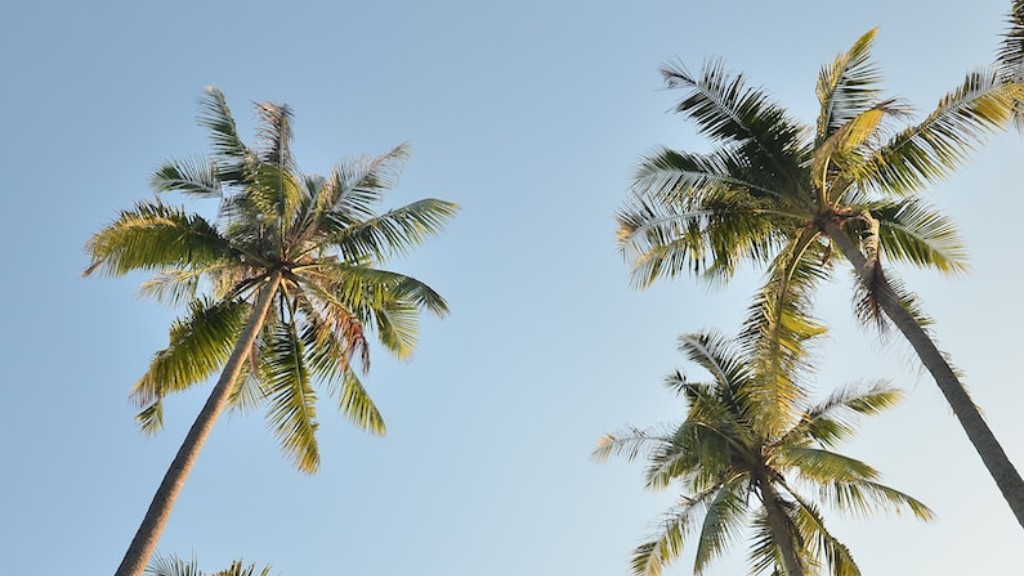Symptoms of a Underwatered Palm Tree
Palm trees require a constant supply of water to remain healthy and vibrant, and one of the most common problems when it comes to keeping a palm tree in an outdoor garden is underwatered stress. Learning how to tell if a palm tree is underwatered is key to successfully maintaining the tree over the long term.
When a palm tree is underwatered, its leaves will start to brown and curl at the edges, becoming brittle and dry. Additionally, the tree’s trunk may become mottled in color or appear distressingly yellowish. A surefire sign of an underwatered palm tree is a lack of fruit. If the tree ever bore fruit and now does not, lack of water is generally to blame.
It’s important to know that, unlike other types of trees, a palm tree will not always show a dramatic effect from underwatering for some time. This is one of the trickier parts of caring for a palm tree, as the damage can easily go unnoticed for months or even years.
Knowing the Source of Stress
Before attempting to determine whether a palm tree is being underwatered, it’s important to identify the source of the stress in the tree. An overwatered tree—or one that receives too much fertilizer—will also start to exhibit yellowing and curling of leaves, so making sure the amount of water and fertilizer being supplied is balanced is key. If the collected water contains high levels of calcium, iron or salt, it can damage the delicate root system of a palm tree and lead to similar symptoms. Therefore, it’s best to only use de-chlorinated water or filtered rainwater, in order to provide the highest quality irrigation that is free of contaminants and minerals.
Taking Precautionary Measures
The best way to prevent or diagnose a palm tree being underwatered is to make sure the tree is given an adequate supply of water from the start. A large palm tree in the outdoor garden should receive approximately one and a half gallons of water per day, in order to guarantee it has enough resources to stay hydrated even during periods of prolonged heat. When the weather is very hot, this amount can be increased to three gallons per day for larger trees, or one gallon for smaller ones.
Additionally, introducing mulch around the base of the tree is a great way to keep the soil’s moisture stable over longer periods of time. During rainy seasons, this is not as beneficial, but during dry, hot months, the extra insulation of well-placed mulch will help keep the soil around the tree moist during longer dry spells.
Providing the Tree with the Right Nutrients
Adding supplemental fertilizer to the soil around the tree is another way to make sure the right nutrients are present to provide the tree with the sustenance it requires to thrive. Slow-release organic-based fertilizers applied as directed on the packaging is the best way to ensure the tree is being nourished in a balanced and controlled way. A typical fertilizer regimen for a palm tree should include a dose of nitrogen and potassium approximately every 3 months. Adding additional iron is beneficial for trees dealing with iron deficiency, and is generally the best method for correcting this type of issue. Additionally, regular doses of Epsom salt can help avoid any imbalances in the tree’s nutrient uptake in the future.
Applying Proper Irrigation Techniques
Making sure the water is being applied evenly around the entire root system of the tree is also very important. Using a soaker hose can be a great way to increase water absorption by the tree while minimizing losses to evaporation. Additionally, allowing the water to flow slightly past the tree’s drip line and then coming back to the base of the tree is the most effective way to make sure the water gets to right where it needs to be.
Monitoring the Tree’s Health
Leaf and root samples can also be taken and monitored in labs to make sure palms are getting adequate nutrients and are not suffering from any deficiencies. If a tree is left unchecked for too long, or if it drops too many leaves, it can take over a year for the tree to recover from a larger nutrient imbalance or a water shortage.
Minimizing Disease Susceptibility
Maintaining an adequate moisture level in the root system is an important way to prevent the tree from suffering from any fungal or bacterial diseases. Spraying the leaves with copper-based, or other organic fungicides, can help reduce the risk of contracting an infectious disease. Additionally, the use of neem oil can help deter pests such as aphids, while also keeping fungal diseases at bay.
Troubleshooting Widespread Deficiencies
If a nutrient deficiency is widespread throughout the tree, it is possible to address the issue by providing more nutrients to the base of the tree using a fertilizer “tea”. This tea is then applied directly to the root system of the tree and can consist of an aerated compost “tea” or an aerated combination of fish/kelp/milk “tea” prepared as directed.
Checking for Signs of Damage
If, after taking all the necessary steps to supplementally increase the nutrients and water the palm tree regularly, there are still signs of weakened health in the leaves, it may be necessary to assess the tree for any potential damage. External beings (fungi, bacteria, pests) or internal imbalance (lack of nutrients) could be causing the weakened condition of the tree. Checking the soil more extensively and using more focused sampling techniques can be beneficial in this case.
Replacing Damaged Trees
In some cases, the damage done to a tree is not reversible, and it might be necessary to replace the tree. Trees that have already suffered from significant root rot, bacterial or fungal disease, and pests, if not treated immediately, can lead to long-term damage that can require removal of the tree.
Preventative Measures for Future Trees
In order to make sure new trees are not allowed to fall into a state of underwatered stress, continuously monitoring the soil for any types of deficiencies and supplementing accordingly is key. Watching for signs of yellowing or curling of leaves and treating them as soon as possible is integral to ensuring the best health of the tree. Additionally, the use of organic-based fertilizer and de-chlorinated water can help reduce the risk of the tree contracting any diseases.
Incorporating Appropriate Pest Controls
Regarding pests, regular monitoring of the tree and any signs of insect infestation is necessary in order to take corrective action. If a problem is noticed, using approved, organic insecticides and removing any dead leaves and dead birds is the best way to reduce the chances of the tree being affected by a fungal or bacterial disease.
Adopting Proper Pruning Practices
Pruning the tree in a way that does not reduce its ability to retain moisture is also important. Pruning should be done sparingly, only removing any dead branches or leaves that can cause health issues. Pruning too much can reduce the tree’s ability to absorb the nutrients it requires, which can be really detrimental to its health.

